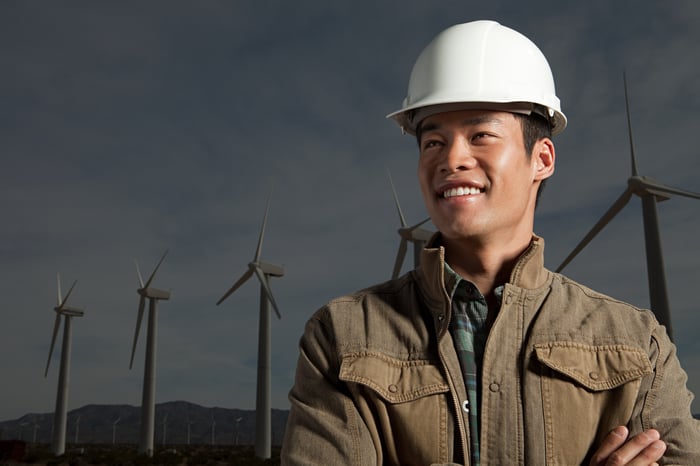The big, long-term story in the electricity space is renewable power. Solar and wind generation is not only renewable, but it's clean, and facilities are increasingly less expensive to build. Utilities like NextEra Energy (NEE 0.54%) have created huge renewable non-regulated power businesses and have massive plans to continue expanding in the space. But The Southern Company (SO 0.90%) isn't following along with this trend. What's going on here?
Building fast
Although NextEra Energy owns one of the largest U.S. utilities (Florida Power & Light), it's NextEra Energy Resources division also makes it one of the world's largest renewable power companies. Companies like NextEra Energy Resources own non-regulated electric assets and sell the power generated to third parties, generally under long-term contracts. This division owns 23 gigawatts of generation capacity, with wind making up roughly two-thirds of the total and solar 11%. The rest is split between nuclear (12%) and carbon-based fuels.

Image source: Getty Images.
NextEra Energy Resources brought on roughly 4.8 gigawatts of renewable capacity in 2017 and 2018. Between 2019 and 2020, it intends to bring on another 6.9 gigawatts or so. This is helping drive swift earnings and dividend growth at the parent company, with projections for 6% to 8% earnings growth through 2021 and dividend growth of an incredible 12% to 14% through 2020. Dividend growth rising faster than earnings is largely possible because of the NextEra's relatively low payout ratio today.
Investors love the story, and have pushed the shares higher to the point where NextEra's dividend yield is a miserly 2.6%, at the low end of the utility peer group. The growth story here is exciting, to be sure, but investors are clearly affording the stock a premium valuation. Then there's Southern Company, which has been bogged down with a delayed and over-budget nuclear construction project. The stock yields 4.6%, toward the high end of the industry. Southern is slowing down on the renewable-power front.
Going a different direction
During the company's fourth-quarter 2018 conference call, management was specifically asked about its non-regulated renewable power plans. CEO Thomas Fanning explained:
I guess we have a placeholder in our financial plan of something like $500 million a year for this stuff. We don't expect to spend it. We expect more to be in the $200 million range and that's really a function of the market.
He noted that Southern Company had been playing a larger role in the space at one point, but that it had since pulled back. Here's the interesting thing: CFO Andrew Evans jumped in to clarify that Southern was still investing heavily in renewable power, but at the utility level. Basically, Southern is leaving the non-regulated renewable market to others. The CFO explained:
[A]s we look at things in the unregulated space, it's not only the margins that have declined, but perhaps the duration of contract and the credit quality of counterparty. It simply falls through some of our return expectations.
Fanning jumped in again, noting:
Value is a function of risk and return. Returns are down in that market in our opinion, risk is up because the duration of the contract available is down. We don't find that all that attractive.
Southern Company is generally a conservatively run utility, so it isn't surprising that it would step back from a sector where it believes risk is increasing and returns are falling. This is an interesting shift that investors might want to think about as they consider renewable power investments. NextEra is large and financially strong, so it can handle some headwinds and, indeed, cherry-pick its customers to focus on only the biggest and best. If things get really bad in in the non-regulated renewable power space, it has the financial heft to adjust. But what about a tiny company like Pattern Energy Group (PEGI)?
Pattern Energy is a funding source for parent Pattern Development. Its $2.1 billion market cap pales in comparison to Southern and NextEra, which weigh in at $53 billion and $91 billion, respectively. And while Southern and NextEra have other businesses to fall back on, all Pattern Energy does is own renewable power assets. If Pattern Development wants to keep expanding, it has to keep building renewable power, even if the financial risk of these projects is increasing. And to fund that spending, it will keep selling assets to Pattern Energy -- which will buy them even if returns start to fall.
PEGI Dividend Yield (TTM) data by YCharts.
Pattern Energy's 7.6% dividend yield is enticing, but if the non-regulated renewable power space is getting increasingly risky, as Southern suggests, then Pattern Energy's business could quickly find itself on thin ice. It's worth noting that Pattern Energy paid out 99% of its funds available for distribution in 2018. That doesn't leave a lot of room for error at this tiny renewable power player.
Still a big opportunity
There's no question that renewable power is still an important part of the energy market. Even Southern is still building renewable projects -- it's just shifting to in-house development. However, the historically conservative utility is hinting that the non-regulated renewable market may be getting a little too hot today, with returns falling and risk rising.
A giant player like NextEra Energy can handle changing dynamics like the circumstances that have led Southern to shift away from the space. But Southern's warning should lead investors looking at more aggressive names, like tiny Pattern Energy, to step back and reconsider the risk-reward dynamics. At this point, conservative investors should probably avoid Pattern Energy and stick with larger players that can handle increasing risks in the non-regulated renewable space (NextEra), or just limit exposure to the space (Southern).






